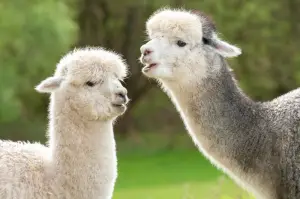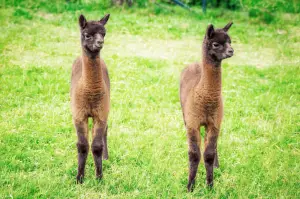What Do You Call A Baby Llama?
Llamas are becoming increasingly popular as both pets and livestock. If you think there is nothing cuter than a llama, you should see a baby llama. These adorable young are just as cute as their parents, with a smaller stature and gangly legs.
What do you call a baby llama? There is nothing cuter than a baby llama, except perhaps the term by which they are called. Baby llamas are called “crias”, a Spanish word for a baby animal. Like many large animals, crias are born highly developed and are able to stand and suckle within an hour of birth.
To learn more about crias and their development, read on for fun and interesting facts about these llama young.
What Other Baby Animals in the Llama Family Are Called 
Llamas belong to the camelid family, in which also reside the alpaca, Bactrian camel, dromedary camel, vicuna, and guanaco. Not all of them have young that are referred to as cria.
The only other “cria” is the baby alpaca. Alpacas and llamas are very similar and have almost identical care requirements. They can be kept together and can even cross-breed with one another if given the opportunity. It makes sense then that they would share the same terminology.
Not only are alpaca babies referred to as crias, but the mothers are also referred to as dams, and the males are either studs or geldings. A group of alpacas is similarly called a herd.
Camels, while closely related to llamas, have babies that are referred to as calves. Intact male camels are referred to as bulls, and females are referred to as cows. Can you guess what a castrated male camel is called? No, not a steer – castrated males are referred to as geldings (or bullocks, in some regions). A group of camels is fittingly called a caravan.
The vicuna and the guanaco are the wild cousins of the llama and are said to be from where the llama and alpaca originated. They have not been domesticated, so not much about their reproductive habits is known. Baby vicunas, like camels, are called calves.
Vicunas are native to the mountainous steppes of South America and are the smallest in the camelid family. Baby guanacos are called “chulengos”. Guanacos can also be found in the mountains of South America and share a habitat with the vicuna.
Additional Llama Terminology
If a baby llama is called a cria, what would you call an adult llama? Many refer to male and female llamas simply as male and female llamas. But llama mothers and pregnant llamas are often called “dams.” Their partners, the intact males, are called “studs.” Unless used for breeding purposes, most male llamas are castrated during their early years – these castrated mature males are called “geldings.” Finally, a group of llamas is called a herd – or, more technically, a “cria herd.”
Baby Llama Fun Facts
Baby Llama Gestation
You may be wondering how long you will need to wait to meet your new cria after your llama has been successfully bred. Like other large animals, llamas have a relatively long gestation period. Crias take about 350 days (or 11 ½ months) of development until they are ready to be born.
Unlike animals that give birth to very under-developed young, crias are born highly mature, able to stand, walk (on wobbly legs), and nurse within an hour of birth. To get a cria to that level of development, there must be a long gestation period.
Female llamas can conceive at any time of the year, and do not “go into heat” like most other mammals. Instead, they are known as “induced ovulators.” Instead of ovulating on a regular cycle, a llama will be triggered to ovulate by an external factor – most commonly, the act of mating.
This is usually considered beneficial, as there are no cycle calendars to keep, and breeding can be planned around the desired season. For example, late Spring and early Summer are typically considered to be best for crias so that they are not immediately exposed to harsh Winter conditions upon birth.
That said, the ideal birthing season for a cria may be different depending on the region, and by predetermining when you will breed your llama, you can give your cria a great head start.
The Birth of a Baby Llama
After a long gestation period, it is time for the cria to be born. Many females will show few signs of impending birth, and because there is a 2- or 3-week margin of error with a healthy cria due date, you may find yourself taken by surprise, walking out to the pasture and finding a new addition.
Crias are almost always born in the daylight hours, most frequently between the hours of 8 am and 12 pm. This gives the cria plenty of time to get oriented before the sun sets (at which time most predators come out – a concern for llamas living in the wild).
Female llamas give birth while standing up; when the baby drops to the ground, the umbilical cord is torn away. The cria most often presents first with its front feet, the head following. Llamas rarely need assistance in birthing, generally able to successfully get the deed done on their own.
Most llamas make wonderful mothers and are immediately attentive to their young, nuzzling them and “humming” affectionately. Because the tongue of a llama does not extend far from the mouth, the mother does not lick away the birth sac as do many other mammal mothers; instead, the sac will dry up and slough off on its own.
It is important that the cria’s father is not present during this time (and in fact, male and female llamas should be separated shortly after mating for the safety of the female). Male llamas can be aggressive breeders and have been seen attempting to mate with a female while she is giving birth – this, of course, has the potential to result in not only the death of the cria but also a potentially lethal infection in the mother.
In addition, male llamas can be aggressive and pose a danger to their new offspring. In the wild or in mixed herds, mothers are often seen giving birth in the middle of a circle of other adult females – the adult females of the herd are there to protect the mother and cria from not only predation but also from the males of their herd.
How Many Babies Do Llamas Have?
Like alpacas and horses, llamas typically only have one baby per pregnancy. This is, in fact, preferred over the expecting of twins, as twins are often born in a much weaker state than a healthy single pregnancy. Twin llama pregnancies often result in miscarriage or stillbirth of one or both young. If both are born healthy, they may need supplemental nutrition. The udder of a llama has a small capacity, and the cria must nurse frequently throughout the day to get the nutrition it requires.
Because a llama is usually receptive to breeding again within weeks of birth, this means that a female llama can theoretically give birth to one cria each year (though because crias do not naturally wean until around six months of age, it is recommended the mother be given a break between pregnancies). Healthy females usually remain fertile until they are 15-20 years old but should not be bred before their second year.
At What Age Can Llamas Breed? 
Llamas reach sexual maturity later than many other mammals. Females have relatively small reproductive systems when compared to other animals of similar size and will not be physically capable of safely breeding until between the ages of 18 and 24 months.
Males take even longer to reach sexual maturity. Their reproductive organs will not be up to the task until they reach around two years of age, at which time, most are moved into a breeding program but held off from actual breeding until they are about three years of age.
Therefore while a female may be able to successfully breed at 18 months of age (this often depends on the size and weight of the animal), a male llama will not be able to successfully breed until he is around three years of age.
Breeding To Have Baby Llamas Is Rewarding When Done Responsibly
When done responsibly, breeding llamas to produce baby llamas is rewarding – there is great joy in watching your young crias frolicking and playing in the pastures. Keeping llamas for breeding does require particular care when compared to the breeding of most other livestock.
Because of the danger a stud can pose to the female alpacas, they should not be kept in what some consider a more “natural” mixed herd. Females must be kept separate from males (both studs and geldings), and males should not be exposed to crias until they are approaching sexual maturity.
If you have an area large enough to accommodate multiple paddocks and pastures, breeding and raising llamas is usually considered more rewarding than challenging. You can learn more about homestead animals in my latest articles here!

